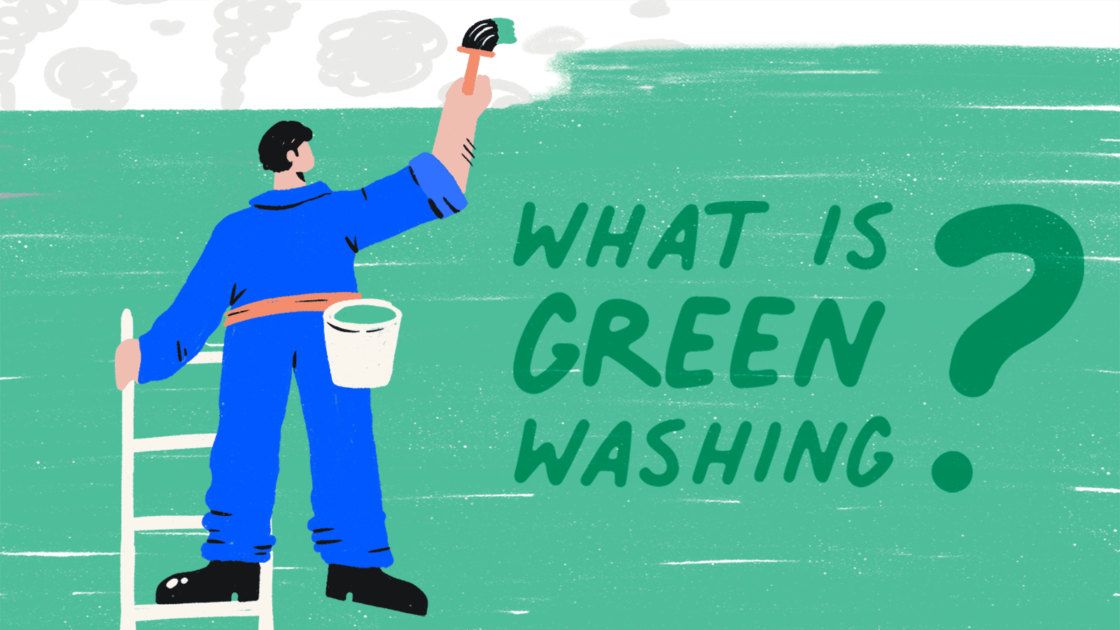What is greenwashing?
Find out what greenwashing is and how to spot it here.


We are more aware now than ever before of the impact our daily choices have on the planet. Many companies realise this and want to show customers how they’re helping to protect the planet and reduce their carbon emissions which contribute to climate change.
However, that doesn’t mean that they’re always telling the truth, or that the changes they’ve made are as positive as they make them out to be. Overstating sustainability is a practice known as greenwashing.
The practice of greenwashing is becoming more common and convincing, which can make it difficult to make more sustainable choices about the things that we buy.
What is greenwashing?
Greenwashing is a marketing technique used by companies to give the impression that their products, practices and policies are more environmentally-friendly than they actually are. It is used to persuade customers to buy a product or service by suggesting that doing so will help the environment. This can be misleading, because things that might seem environmentally friendly often have a hidden cost to the environment that we’re not aware of.
The practice of greenwashing is not new but it has become more common and harder to recognise in recent times.
Why do companies greenwash?
In recent years, public awareness and concern about the environment has grown. Many people are conscious that their consumer choices can have a negative impact on the planet and want to make more environmentally-friendly decisions. With more people willing to spend on items that they believe are good for the planet, companies know that they can sell to those people by appearing sustainable.
However, many of these companies spend more money on marketing the message that they are sustainable than on actually taking steps to reduce their environmental impact. When they do this, it is known as greenwashing.
Some greenwashing is unintentional and arises from a lack of understanding about what being environmentally-friendly truly is. Companies might have impressive, carbon offsetting initiatives at their head office, but are overlooking the issues with their supply chain (the steps in the process of turning raw materials into their goods).
However, most forms of greenwashing are carried out with the intention to exaggerate minimal efforts to be sustainable.
Why is greenwashing a problem?
Greenwashing is problematic for people, companies and the environment. It makes it harder for us to make truly informed decisions about how we spend our money and those decisions may actually be harming the environment – even when we had the opposite intention. This can make it harder to trust truly sustainable products because it can be hard to tell if something is greenwashing or not.
Greenwashing can allow a company to increase their profits, while maintaining a good public image. It could encourage them to keep misleading the public and damaging the environment.
What are some examples of greenwashing?
There are many ways a company can engage in greenwashing. Often, these tactics will be combined to strengthen the public perception that they are sustainable.
Using ‘eco-friendly’ or ‘green’ buzzwords
One of the most common forms of greenwashing is using language that is meant to describe truly environmentally friendly products and practices.
Using buzz words like “eco-friendly”, “green”, “conscious” and “sustainable” can give the impression that the product was made with materials and practices that cause little or no harm to the planet. However, there’s no one agreed definition as to what these words mean, and there are no laws around how they can be used. Brands can adopt these terms and apply their own meaning to them.
This means that brands can market themselves as “green” or being “made with sustainable materials” without having to give evidence to back it up.
Avoiding systemic issues
Sometimes companies will try to claim that they are sustainable by focusing on one feature of their products and practices while ignoring more important environmental issues.
For example, a company may highlight the fact that their t-shirts are made from recycled materials but avoid mentioning that their manufacturing process involves unfair and dangerous labour practices, toxic chemicals and uses energy from fossil fuels.
Many companies will also state that they pay minimum wage. Where that is close to a living wage in Ireland, it is very far from a living wage in other countries where garments are often made. Ethical brands should list the names and locations of the factories involved in making their products, ensure safety and operate under Fair trade.
Using false labels
Certification labels – like the Leaping Bunny logo to show that something is cruelty free, or the FSC (Forest Stewardship Council) logo that aims to protect forests – are a way of verifying if something was sourced sustainably.
However, sometimes companies will make their own versions of these symbols that look similar to the original, to try and trick people into believing it’s sustainable. They might also invent their own labels that aren’t attached to any organisation. It’s worth looking online to check any logos that companies are using and making sure they’re real before trusting them.
Completely false claims
Sometimes a company will lie about their practices in order to portray themselves as sustainable.
For example, some clothing companies will encourage customers to donate their old clothes in exchange for store vouchers. While this is promoted as a circular fashion system in which the donated clothes can be recycled into new products, it is not always the case. Often, this tactic is used to encourage a customer to stay loyal to a brand and continue to shop using their vouchers. While some of the items may be recycled, it is possibly not as much as the company claims.
Globally less than 1% of clothes are recycled as clothing because of a lack of technology, according to the Ellen MacArthur Foundation. Most recycled clothing is downcycled into things like insulation.
How to stop greenwashing
Once you’re able to spot greenwashing, you can do your best not to buy into it. Keeping an eye out for greenwashing can be difficult, it involves doing a lot of your own research, considering whether claims are true and finding brands that are trustworthy. What matters is that you’re making an educated decision and doing your best, it may not work out every time but sustainability is about learning as you go.
There are a few ways you can help make other people aware of greenwashing so the marketing practice has less success:
- Inform your friends and family of common greenwashing practices, use well known companies that greenwash as an example – like oil companies, fast fashion brands, plastic bottle production companies.
- Watch documentaries on the climate crisis and read up on what well known companies have already been discovered to be greenwashing.
- Call out greenwashing when you see it online – comment or message the page to let them know you see it.
- Email companies (especially small or local ones) you think might be greenwashing about how they could potentially do better when it comes to sustainability practices.
- Join sustainability activist groups online or in your community to keep up to date with green news and campaign against greenwashing.
Cover image by Cathy Hogan






